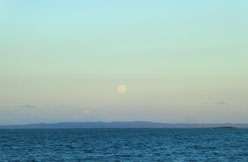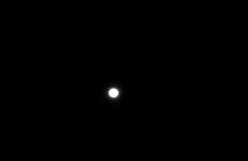Friday's Blue Moon and lunar size-shifting explained

(Phys.org)—A lunar event that occurs once in a blue moon will happen this Friday night, August 31.
Look at the night sky and you will see a full moon, the second this month ( the first was August 2). Two full moons in the same month occur just once every 2.5 years or so.
QUT astrophysicist Dr Stephen Hughes said we had a full moon on August 2 and the next on August 31, the blue moon, will make two "squeezed" into one month.
"Blue Moons occur only about seven times in 19 years—that's about once every two-and-a-half years," Dr Hughes said.
"A bit like the leap year, a blue moon happens as a calendar catch-up because it takes the moon about 27 and a half days to go round the earth and since this is less than the number of days in a calendar month, two full moons can sometimes occur in a single month.
"If you get paid fortnightly you might notice that you sometimes get paid three times in a month rather than the usual twice. These 'blue pays' occur about as frequently as blue moons."
Dr Hughes said a blue moon was not coloured blue although the moon could appear blue when there were smoke or volcanic ash particles suspended in the atmosphere.
"A blue-tinged moon is a rarity and so maybe that's where the saying came from. There are reports of blue moons after the Krakatoa eruption in Indonesia in 1883 in which volcanic ash was ejected 80km high, on the edge of the ionosphere," he said.

"When it is high in the sky, the moon shines with a white light reflected from the sun. At moonrise the moon can appear either yellow or orange but when there's a lot of smoke in the air, after a forest fire, for example the moon can appear red.
"The moon looks red because the blue component in moonlight is scattered in the atmosphere so the remaining moonlight contains more red."
Dr Hughes said while musing on the moon we should look at another mystifying phenomenon: when the moon rises or sets below the horizon it appears much larger than it does when it's higher in the sky.
Dr Hughes and QUT PhD student Adam Ellery used digital cameras to test whether the moon is actually larger close to the horizon or if it is an illusion.
"Adam took photos of the full moon over the sea (Moreton Bay) and I took some photos of the moon inland: close to the horizon at Murrayville in south western Victoria and another at an elevation of about 60m in the Adelaide Hills.
"Our experiment showed that contrary to what our eyes tell us, the moon is actually smaller at the horizon."
The apparent increase in the size of the moon at the horizon is called the moon illusion. It is caused by refraction, a process whereby light rays take longer to pass through the middle of the lens because it is thicker there.
"This means the light rays exit the edges of the lens first and the central rays emerge later. The net effect is bending of the rays towards a point beyond the lens called the focus.
"The curved atmosphere of the earth acts like a lens, so when a ray of light from the moon passes into the atmosphere it is deflected.
"The rays from the bottom of the moon come into the atmosphere at a slightly shallower angle than the top of the moon and so get refracted more, resulting in the moon being scrunched in the vertical direction.
"When the moon is high in the sky, the rays strike the atmosphere vertically and are hardly deflected so the moon stays the same shape."
He said the apparent size of the moon does actually change slightly throughout the month because the distance between the centre of the earth and moon varies between 362,000 km and 405,000 km. However, this accounts for only about 10 per cent of the change in the diameter of the moon throughout the month.
More information: A free version of the journal paper on this experiment can be downloaded from eprints.qut.edu.au/53017/ .
Provided by Queensland University of Technology


















